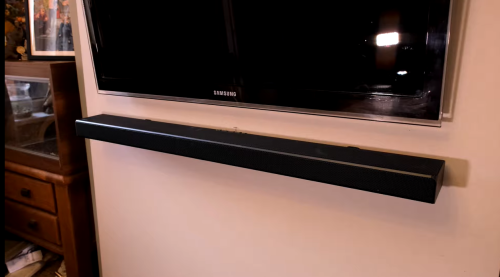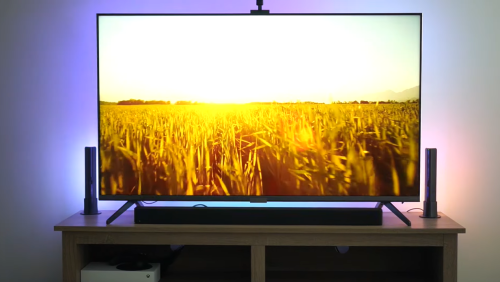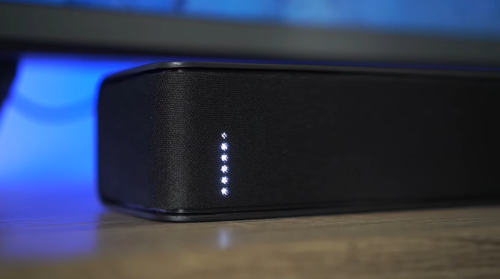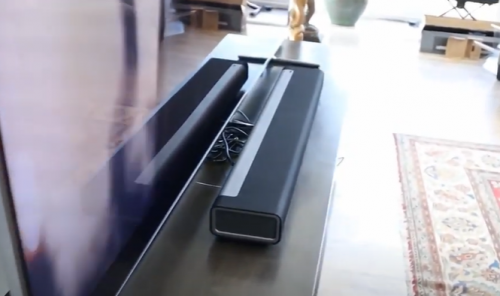When looking at a soundbar’s specs, wattage is typically considered first because a louder soundbar is usually assumed to be better. But really, the number of watts is trivial. It is a marketing trick that could end you up with a bad product.
Still, the question “What wattage soundbar do I need?” remains. This guide, created by our experts, should help answer that and prevent buyer’s remorse.
Soundbar's Wattage Explained
Meaning of Soundbars’ Specs
The quality you’re getting with the speakers isn’t reflected in the wattage. Just because you got a soundbar with a higher number of watts doesn’t mean it’s a better product. The reason you’re buying a soundbar is to get good sound – and you won’t know that by looking at watts.
When picking out a soundbar, you should check out other specs as well. Here, our experts explain the meaning of common soundbar specs to help you make sense out of the numbers often listed on the products.
Soundbar Watts Meaning
Simply explained, watts measure the power coming from an amplifier. Watts in amplifiers refer to the amount of power output. In normal speakers, watts refer to the amount of power input.
Manufacturers always state the number of watts for normal speakers. That’s because it tells you the maximum power that a speaker can handle without breaking down.

However, soundbars have a built-in amplifier unless it’s a passive model. Most soundbars drive the speakers with the amplifier that’s built into the device. In most cases, manufacturers state the output watts for the amp.
Decibels and Speaker Sensitivity
Instead of the watts, the decibels is the spec you should look for when picking a soundbar. It’s usually labeled as dB (the abbreviation for decibels). The way that the dB is measured is by giving the speaker 1 watt of input power, and then measuring the decibels from 1 meter away.
The sensitivity of the speakers refers to how much power a speaker can convert to sound. Therefore, the higher the sensitivity is, the louder the speaker is going to be. For a more accurate measurement, you can use any of these decibel meter applications here!
Decibel Levels (dB)
Now that you know what decibels are, you might be wondering about the number you should be looking for in a soundbar. Higher decibels mean louder sound, but it’s tricky to tell how loud it can actually be with just a number.
Here are a few examples that you can use as a reference.
A normal conversation and an electric shaver are about 60 dB. At 70 dB, the volume is comparable to a noisy restaurant or a hairdryer. Going up at 80 dB, you can hear the average dial tone and a vacuum cleaner.

At 90 dB, the volume is like a tractor or the subway. If you move up to 100dB, it sounds like a motorcycle or a blender. Going further than that would damage your eardrums with continued listening.
For soundbars, 85 to 88 dB is a good number. If you want some powerful sound though, our experts recommend getting a soundbar over 90 dB.
There are also soundbars that go up to 125 dB. However, it would sound like loud bar music at this point.
Watts vs dB
The difference between watts and decibels might be confusing. But basically, a watt is a measure of power while a decibel is a measure of loudness.
However, the relationship between the two is not linear. For example, when you compare a 50-watt speaker and a 100-watt speaker, the only difference in volume would be 3dB. If you want to increase the loudness by 10 dB, you would have to increase the power 10 times.
Frequency Range
For a speaker, the frequency range refers to the lowest and highest frequency that it can produce. Frequency (measured in Hertz or Hz) is the pitch of the sound, so low-frequency tones would be the bass and high-frequency tones are produced by the tweeters.
In all the tests we’ve done with multiple soundbars, they all sound best in the midrange frequencies. That’s because most speakers try very hard to balance its lows and highs, and they’re not especially good at producing bass – which is why there’s usually a separate subwoofer.
Channels
Channels are also a major soundbar spec you should consider, particularly because a higher number means a more immersive sound.

Entry-level soundbars generally have 2 or 3 channels. That means a 2-channel soundbar has left and right speakers, while a 3-channel soundbar has left, right, and center speakers.
For higher-end soundbars, you might see something like “5.1” or even “5.1.2”. The first number refers to the number of channels on the soundbar, the second is the number of subwoofers, and the third is the number of overhead speakers that generate sound from above [1].
How Soundbar Specs Can Cause Confusion
If you compare different brands and models of soundbars, it’s easy to get confused by just looking at the specs. That’s because there’s no steadfast rule on how manufacturers provide the labels.
For instance, some models will have the usual specs like watts and dB but others may completely skip the figures. You can also find units that refer to certain specs as different names, like using “system power” for defining watts.
This makes the process harder when you’re trying to find a soundbar. That’s another reason why it’s best to read reviews like the ones we have so you can get real answers on the soundbar’s quality.
How to Know if a Soundbar is Good
Continuing on that note, the best way to really know if a soundbar is good is to read reviews. You can’t really test every soundbar you’re considering, so doing your research will let you know the results of other people’s tests.
We do recommend getting your info from legit sources. In our site, our audio experts test each soundbar for review.
Sonos Playbar Watts
A good example of a confusing spec sheet is that of the Sonos Playbar’s. When you look up the specs of this soundbar, there are no figures for dB, power, or frequency range. For some, this makes it difficult to know the basics of the model.

However, it does tell you that there are “nine Class-D digital amplifiers” and that it has Dolby Digital compatibility. In a way, this can be a good thing because numbers aren’t the sole measurement of sound quality and performance.
See how the Playbar’s specs fare against the Bose Soundtouch 300 here.
FAQ
How many watts does a sound bar use?
A sound bar uses 20-50 watts by itself. If you have subwoofers and rear speakers, the wattage increases because you have additional devices.
Does wattage matter for sound bars?
No, wattage doesn’t matter for sound bars. A higher wattage doesn’t necessarily mean better sound, although it contributes to it. Still, it’s best to check other specs like speaker sensitivity and audio format decoding systems.
Does more watts mean better sound?
Yes, more watts mean better sound in some cases. That’s because your speakers will sound louder and smoother if it can handle more power.
Does more watts mean more bass?
Yes, more watts mean more bass if you’re using an external subwoofer. The power of the subwoofer depends on the wattage, so you get a boosted bass if your subwoofer has more watts.
Is 300 watts loud enough?
Yes, 300 watts is loud enough for soundbar systems. This wattage usually involves more speakers, making the sound more immersive
Conclusion - How Much Wattage Do You Need In A Soundbar?
Our answer to the question “What wattage soundbar do I need?” is this: wattage isn’t the most important thing in a soundbar’s spec sheet. While more watts can mean better sound, it still isn’t a hard fact.
Other specs, such as the number of channels and frequency range, would give you a better idea of a soundbar’s performance. It’s best to read reviews as well to determine the actual performance and sound quality of the soundbar you’re eyeing.
Have a tight budget but don’t want to skimp on sound quality? These soundbars below 400 will still deliver even with a cheaper price tag.
